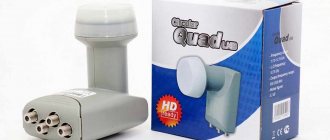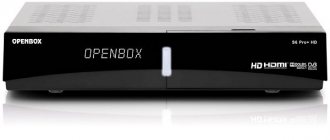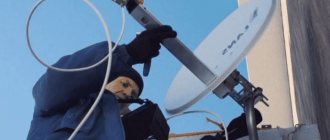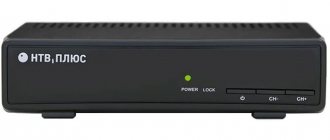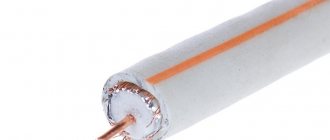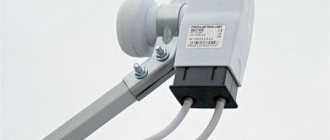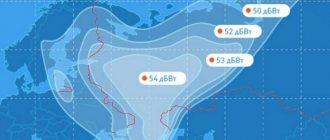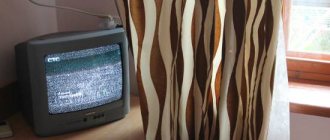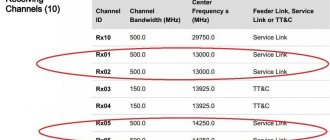Satellite TV can be connected to 2 TVs in different ways - using a second tuner (receiver), using an RF module, etc.
One set of equipment for connecting to satellite television is designed to connect only one TV. Therefore, to connect two or more TVs, additional elements or another set of equipment are required.
Satellite TV for several TVs
Receivers for connecting two TVs
If one of the devices has not only an input, but also an output socket for an antenna (not to be confused with a modulator socket - it is designed to connect the device to a TV via high frequency), then you can connect a cable to this socket, which is designed to connect satellite antennas to receivers . Connect the second end of the cable to the input jack of the second receiver. You will get a serial connection of the converter and two receivers. If you receive encrypted channels, you will have to purchase a separate card for each receiver and pay a subscription fee. In addition, with such a connection, it will not be possible to watch channels with vertical polarization on one receiver, and with horizontal polarization on the other.
With this connection, the slave (second) receiver must be configured so that the “Power” option is disabled. Otherwise, problems may arise when viewing channels.
This connection option makes sense when the user wants to use one TV, for example, only for watching paid channels, and the other for free ones.
You can use a splitter that is designed for satellite receivers and converters. This connection method will have the same disadvantages as the previous one. Additional equipment must be used if none of the receivers has an output jack for connecting a second device.
Installation of 2 converters on the antenna
If you install 2 converters (“heads”) on the antenna, you can connect them to two different receivers. They will work independently of each other.
But there is such a drawback: 2 converters cannot be directed to one satellite. You will have to watch different channel packages from different satellites. If the channels are encrypted, you will have to purchase 2 cards and pay 2 subscription fees.
Installing a converter with two outputs
Another option is a converter with two outputs. One of them can receive channels with vertical polarization, the other - with horizontal polarization. Both outputs need to be connected to a multiswitch, and parallel cables should be drawn from it to the TVs. On any of them you can watch channels that are broadcast in any polarization. All required switchings will be automatically made by the multiswitch. But for each receiver you will need a separate card and subscription fee.
If you want to use one receiver and one card, and the receiver has a high-frequency modulator, then you need to connect the modulator output to two TVs through a splitter, which is designed for terrestrial antennas. Both TVs need to be tuned to the satellite TV channel that the modulator broadcasts. When you change the channel on the receiver, it will simultaneously change on both TVs.
You can connect one TV at a low frequency (for this you will need RCA or SCART connectors), and the second at a high frequency (for example, through a modulator). The result will be the same, but with this connection, you can connect a regular indoor or outdoor antenna to the first TV and independently receive over-the-air channels. And if one TV is connected via RCA, and the second – via SCART, then you can watch channels from a regular antenna on both TVs.
You can connect satellite TV to two TVs and through one receiver. In this case, the first device is connected to the first TV using a “tulip”, and the RF module is connected to the second output on the tuner, which is intended for connecting other monitors.
This method has many disadvantages. You can only change channels in the room where the receiver is located. And the main drawback is that both TV receivers show the same channel.
How to connect two or three MODERN SMART TVs to one active antenna
Our expert Stanislav Boush Says:
In order to connect two or more TVs (that is, the TVs already have a built-in tuner to receive 20 free digital channels) to one active antenna, you need to understand HOW TO CONNECT IT TO WORK!
(video on how to connect two DVB-T2 digital units to one active antenna is at another LINK).
Questions we will discuss:
-an active or passive antenna is more suitable for branching, indoor or outdoor; -where is it convenient to install a splitter and is it needed? -what type of splitter should be - regular or pass-through.
1. What kind of antenna do you have - active or passive?
A passive antenna does not have an amplifier using transistors or microcircuits. Reception occurs by pointing the antenna towards the TV tower. The antenna is designed in such a way that the signal is amplified from one direction and weakened from all others. The reception sector is usually 10-20 degrees; very good antennas can even be 5 degrees. That is, the stronger the antenna, the more accurately it must be directed to the source of the TV signal. If you need a powerful antenna, it must be long. The correct maximum length of a passive antenna is approximately 1.3 - 1.5 meters. There are antennas without an amplifier 2-2.5 meters long, but this is necessary for reception from 80-100 km. And by the way, it’s not a fact that everything will work out.
If the antenna is passive, that is, it does not require power because it does not have an amplifier, then everything is more or less simple. The main thing is to first set up an antenna with one TV, achieve maximum signal, and only then start dividing it into two, three or more TVs.
To separate the signal, a special divider was invented. You can’t just twist three pairs of television cable into an asterisk! Because the entire signal will be lost in such a twist. The laws of electrical connections at high frequencies operate differently. Here is a special divider that allows you to send a signal from one antenna to two TVs. The divider always indicates an input (IN from the antenna) and two outputs (OUT to TVs).
Special F-connectors are screwed onto the cable and with them the TV cable is connected to the threaded connectors of the divider. Everything is very convenient and simple.
So, if the antenna is without an amplifier, everything is clear, but what if it is necessary to strengthen the signal even more, because the passive antenna is rather weak? Then the antenna must have a built-in amplifier. That is, the antenna is active. How to determine this? Very simple. Display information about the signal level and quality on the TV screen. To do this, press the INFO button on the remote control once, twice or three times. This function is available in all digital set-top boxes (but not in all SMART TVs).
INFORMATION ABOUT SIGNAL LEVEL FROM ANTENNA AND QUALITY IS IMPORTANT
If the signal intensity and quality are more than 80%, the signal can be divided. If it is less, it must first be amplified, otherwise the signal may begin to drop out and fade. That is, instead of a passive antenna, you need to switch to an active one or take a more powerful active one. Place the antenna higher and aim it more accurately.
POWERFUL ROOM DIGITAL ANTENNA T-3320 produced by ANTENNA.RU can be used on several TVs.
This applies to both outdoor and indoor antennas. For example, instead of the usual Chinese Antenna and Ring antenna, I recommend using a powerful modern indoor antenna T-3320 produced by ANTENNA.RU for several TVs or tuners.
VIDEO ON YOUTUBE HOW TO CONNECT TWO TVS TO ONE ANTENNA
2. Active television antenna.
It must be taken into account that the signal for two TVs will be divided according to power, that is, only half of the received signal goes to each TV. That is why the use of an active antenna is recommended for two or more television receivers.
AGAIN: An active TV antenna differs from a passive one in that there is a television signal amplifier inside it. for example, like this:
In order for the amplifier to work, it must be supplied with supply voltage. In modern antennas, power is supplied through the central core of the cable. Most often the supply voltage is 5 Volts. But it is always advisable to clarify this in advance. How to supply 5 Volt power to the antenna via the antenna cable? And also split the signal into two TVs?
For modern SMART TVs, the simplest solution is to purchase a power injector. It is this injector that will supply +5 volts of power to the central core of the cable. The injector is installed next to the TV in the gap in the antenna cable.
A power injector without an LED indicator indicator is an extremely mysterious thing - it is absolutely unclear whether it received power from USB, whether it supplied 5 Volt power to the active antenna - without an indicator, all this is a mystery shrouded in darkness. This is why I recommend the Triad-311 power injector (a link to it is at the end of the article).
We connect the USB injector to any USB on the TV, but preferably to a mobile phone charging unit. Sometimes power is not supplied to the USB of the TV (in some TVs, power is supplied to the USB ONLY IF YOU SELECT WATCH A MOVIE OR LISTEN TO MUSIC FROM A FLASH DRIVE IN THE TV MENU), so it is better to use a mobile phone charging unit.
A power injector without an LED indicator indicator is an extremely mysterious thing - it is absolutely unclear whether it received power from USB, whether it supplied 5 Volt power to the active antenna - without an indicator, all this is a mystery shrouded in darkness. This is why I recommend the Triad-311 power injector (a link to it is at the end of the article).
The cable from the antenna is connected to the MAMA injector plug, the MALE injector plug is connected to the input jack of the signal divider. In this case, it is better to use a divider without a thread, but with television connectors. The splitter outputs are connected to two TVs.
You will need adapters from the F-connector to the TV-Male and TV-Female plugs, 3-5 pieces each, depending on which connectors on the divider are smooth or threaded.
In the power injector Triad T-311/antenna.ru, when the injector is connected correctly, the indicator LED lights up. This is a huge advantage! There is no indicator on injectors from other manufacturers. Therefore, it is impossible to understand whether you connected the injector correctly or not. Use Triad T-311/antenna.ru and you will succeed!
3. Two TVs, but there is a receiver for receiving digital TV.
A modern digital television receiver allows you to easily connect two TVs to one antenna.
On the back side of any DVB-T2 receiver there is a bunch of necessary connectors. Let's use them!
We connect the active antenna to the antenna input jack (the leftmost one). To the right of it is the antenna output. It is this output that we use to connect a second TV. Using an antenna extension of the required length (up to 20 meters). We connect the first TV to the receiver via AV or HDMI connecting cables. AV is included with any tuner, HDMI cable must be purchased separately.
Well, now the most important thing:
We turn on the power of the active antenna in the menu of the first tuner. To do this, press the MENU button
on the tuner remote control and look for Antenna Power. Switch from OFF to ON and now the antenna works!
Of course, the second TV will receive an already weakened signal, but usually this is enough. You can also organize signal reception on 3-4 TVs. Especially if the TVs are outdated and you still need to buy TV receivers for them.
So it's very simple. All products described in the article can be purchased on the website antenna.ru using the links below. Click on the product pictures and buy!
This is what it will look like - everything is very simple and no additional devices are required to connect a second receiver - just an extension cord.
So, if the TV is new, then you can simply take the signal from the receiver from the output, and if the TVs are not new, we feed the antenna from one of them, and build the rest in series. We will do the same with the third receiver. Happy fourth, with... but how many receivers can be connected in series in this way depends on the signal level from the antenna, the quality and length of the cable. In addition, on each receiver the signal is divided into hits according to power. Thus, this method can not be used indefinitely.
4. Connecting several televisions and receiver units using feed-through dividers.
A pass-through divider is one that passes current to power an active antenna. There are two types of dividers - ordinary ones (they do not allow current to pass through) and these are the same through ones. The difference in price is most often insignificant.
Pass-through dividers differ from ordinary ones in the color of the label. Regular - black label. Passing - red or with red arrows showing how the signal can pass. But it’s better to check with the seller just in case. In the photo on the left is a regular divider by three, on the right is a pass-through divider by two. The Power pass inscription also helps to understand that this is a pass-through divider and shows how power can be supplied.
That is, you supply power to the central core of the cable in your apartment (including power in the receiver menu or using a power injector), and the current flows through this central core through all the signal dividers through to the antenna, which is located, for example, on the street. Why is this necessary? Sometimes it is impossible to consistently deliver a signal to each TV or digital TV receiver. For example, there are two floors in a house, we divide the signal and then go sequentially from receiver to receiver separately along the first and second floors, as in the first part.
Here's what it might look like:
This connection diagram allows you to turn on the power to the antenna by the receiver closest to the antenna, either on the first or second floor. If you turn on both, nothing will happen; the diode protection of the receiver should work. But, as they say, it’s better to check. This is very convenient - I turned off the receiver on the first floor - and the antenna works, since the power is supplied from the receiver on the second floor.
Issues that we will discuss in the following issues:
-active or passive antenna; -where it is convenient to install the splitter; -what type of splitter should be - regular or pass-through.
So, a pass-through divider is one that passes current to power the active antenna. That is, you supply power to the central core of the cable in your apartment, and the current flows through this very central core to the antenna, which is located, for example, on the street. This is exactly what is done in a satellite dish, and the same can be done with a TV antenna.
Once again, you need to turn on the antenna power in the tuner menu of the receiver closest to the antenna.
That's all for today. Expert Stanislav Boush was with you.
In the next article I will tell you where to point the antenna to receive 20 channels of free digital television , how to actually find out where to turn the digital antenna, where the digital TV transmitter is located and about the digital reception map - the location and coverage area of the digital signal in Russia.
Divider installation
There is an option to use a splitter or splitter. These parts divide the signal from the antenna into 2.
This branching option has screw sockets. One end of the cable is stripped, inserted into the nut, the second with a similar plug is connected to the TV. There is a special hole in the splitter screw socket for the central antenna cable. You need to insert the end of the cable there, tighten the nut, and press the copper sheath tightly against the body of the device.
The procedure for connecting a satellite dish to two TVs is different for each model.
Instructions
Purchase a special cable of appropriate length, as well as a splitter with two outputs. The image quality will depend on the cable.
If one TV is already connected to the antenna, then the end of the cable must be removed from the TV and inserted into the output port on the separator, tightening the nut tightly.
Cut off a small end of the cable from the common skein, put standard plugs (heads) on the ends, and clamp them.
In the same way, connect the plugs to the large (remaining) piece of cable that will be used to connect the channel splitter and the second TV.
Plug all the plugs into the corresponding connectors on the body of the splinter and the TV.
Hide the cable that goes to the second TV under the baseboard or somewhere else so that it does not get underfoot. If possible, it is better to drill into the wall to run the cable to the second TV. This will make it possible to use a shorter cable length.
After connecting the antenna to two TVs, check the image quality on both receivers. If the quality is not very good, then check the fastening of all plugs at the ends of the cable and tighten them tighter.
Settings
- Press the menu button.
- Determine the desired source for the signal, select it.
- In the selected source, mark the connector to which the TV is connected.
- Start searching for programs.
- After completing the search, remove from the general list those channels that do not have a clear image.
How to choose what types of devices exist
When choosing, you should take into account two factors: the number of connection points and how far they are located from the antenna.
According to the main characteristics, the multiswitch is divided into:
- Power supply: from 220 V and from 18 V.
- Available number of input and output ports.
Multiswitch for a satellite dish for 4 TVs
The number of points will allow you to understand how many outputs are needed to completely absorb the signal.
Cascadable or terminal
The distance to the antenna directly affects the required type of multiswitch: cascaded or terminal.
Cascadable and terminating multiswitch
Cascadable is widely used in apartment buildings, corporate offices and residential buildings with a large number of people.
A device of this type does not require power and is added in a chain at the place where the signal is routed (often, each floor in the building). It is important that the devices are connected to each other. If it is necessary to connect a signal amplifier, a power injector is connected, which requires an AC outlet with a power of 220 Volts.
The terminal type of multiswitch is recommended for installation in private homes or in small rooms. This is due to the close distance to the antenna. The device is included in the switchboard, because it is where the cables from the antenna go and from which the cables go to the receiver.
The terminal multiswitch requires electricity. That is, within a meter radius there must be an outlet with an alternating current supply of 220 Volts.
Active and passive multiswitches
There are also categories such as active and passive multiswitch models. The active model includes an integrated signal amplifier. This feature is necessary if you also need to connect an over-the-air antenna.
To simplify the choice, some brands label their products as follows:
- P – passive.
- A – active.
- U – universal type.
This option is not provided for the passive category. To do this, connect an additional external amplifier, which will have to be purchased separately.
Passive and active multiswitches differ in the parameters of the input signal: the passive one will produce a lower value.
What is a multiswitch, purpose and application of the device:
The best option for connecting a satellite dish to several TVs
To watch different TV channels on 2 (3, 4, etc.) TVs, you need to connect a separate tuner to each of them. But such an elegant cable solution is very expensive.
You will need 3 separate cables, from the converter (“antenna head”) to each receiver - a separate cable. For this, there are special converters with different numbers of outputs - 2, 4, 6, 8. Accordingly, if you want to connect satellite TV to 3 TVs, you will need a converter with 4 outputs.
Splitter
It is considered the most financially profitable way to connect. The signal can be received from any satellite, but such a system will not always work acceptable.
Multiple output converter (LNB)
There are several modifications of this element, each with a different number of outputs - 2, 4, 8, 16. Each TV needs a receiver, or the TV must have a built-in DVB-S2 tuner and a CI+ slot for the CAM module. A separate cable is pulled from the converter to each TV.
There are convectors of the C and Ku ranges. All paid satellite television operators operate in the Ku-band. Ku-band satellite converter (LNB) is divided into:
- circular (“Tricolor-TB - Siberia”, “HTB-Plus-Vostok”) polarization;
- linear (“Continent-TV”, “Orient Express”) polarization.
This type of convector is considered the most reliable connection option with a minimum number of connections.
ST for several TVs
There is another option for connecting multiple TVs to multiple satellites. If it is necessary to connect a large number of subscribers to one antenna, then a special device is used for this - a multiswitch, which divides the signal into several convectors. Most often, this element is used to create a network with a large number of users (for example, in urban apartment buildings). If you need to connect CT to several TVs in a private cottage, then it is more convenient to use convectors with independent outputs.
CT from several satellites to several TVs
For this connection option, in addition to convectors with independent outputs, devices such as “diseks” (“daiseki”) are also required. They are designed to receive signals from different satellites via one cable. Dishes are adapted for different protocols. The protocol standard for which a particular drive is intended is indicated on the packaging or on the device itself. For example, “DiSEqC 1.0 – up to 4 convectors.” For the entire system to work, the receiver must also support the standard for which the disc is selected.
Connection to an antenna with amplifier
An active antenna is an antenna in which an amplifier unit is used. Power is usually supplied to the amplifier via an antenna cable. To connect several devices in such a situation, two methods are used.
Using a splitter
The active antenna amplifier must be powered. But this cannot be done through a regular splitter, because it contains elements that prevent the passage of voltage necessary to power the device.
Power can be supplied to the amplifier if you use a special splitter with a power pass (Power Pass).
Diagram for connecting TVs to an active antenna through a special splitter
With this connection, television receivers are divided into active (through which power is supplied to the antenna amplifier) and passive.
Regular splitter
It is possible to use a regular separator. In this case, power to the antenna amplifier can be supplied between the antenna and the splitter.
TV connection diagram via a regular divider
As a result we have:
- the amplifier is powered with the required voltage;
- the signal from the antenna amplifier goes through the splitter to the television receiver.
If you need to connect several TVs, use a splitter with the required number of outputs. The connection diagram is the same.
If there are unused outputs left in the splitter, then you need to connect a ballast to them - a 75 Ohm resistor.
Special offer from Tricolor-TV - set for 2 TVs
This operator makes a unique offer to customers - a special set of equipment for two TVs. This is considered the optimal connection option, because it is possible to satisfy the interests of all residents of one apartment without significant financial costs.
The most complete kit, which will allow you to connect everything without unnecessary hassle, includes:
- an antenna (“dish”) equipped with a converter with two outputs;
- receiver GS E501, which combines the functions of two tuners (or another receiver model with similar capabilities);
- attachment GS C-591;
- 2 remote controls and 2 power supplies;
- access card;
- cables for connecting equipment to the antenna;
- “twisted pair” for connecting the set-top box to the receiver;
- HDMI cables for connecting TVs to set-top boxes;
- documents and instructions.
If you have a receiver with two tuners installed, you can purchase a client set-top box. It costs less than a regular receiver, but you will need to pay separately for the viewing service on two TVs. In addition, the operator offers to exchange, with an additional payment, the existing equipment for a new one.
There is no need to install a double converter on the antenna instead of a single head with one output. It will be enough to install an antenna divider near the receiver, where the coaxial cable fits.
Easy connection
A smart card is inserted into the main receiver (CS E501); there is only one in the sales kit. Two coaxial cables coming from the two converter outputs on the antenna are inserted into LNB IN inputs No. 1 and 2 on the same device.
The device plays the role of a server that is capable of decrypting the signal and transmitting it to the GS C-591 client set-top box using a twisted pair cable. After this, all that remains is to connect TVs with set-top boxes using HDMI cables, and you can start searching for channels.
You can configure both devices to adequately display the signal using the appropriate instructions, or use the tips in the video. If everything is done correctly and the operator’s services are paid, then both TVs will show channels independently of each other.
Advantages of this connection option:
- Firstly, there is no need to install a second antenna.
- Secondly, you don’t need to buy a second receiver if you buy a client set-top box, which costs less.
- Thirdly, connecting to one TV costs 1,500 rubles, and to two – 2,000. A system for two TVs costs 1 thousand rubles less.
Satellite dish for 2 TVs: how to connect correctly
Thanks to modern technologies, 2 TVs can show from one satellite dish. Technology in our time gives a person a lot of opportunities. Not so long ago, having a TV in our home that showed several channels was considered an achievement. Nowadays, TV can show hundreds of channels, but this is no longer enough. Many users want to install two TVs at once that receive satellite signals and get a high-quality image.
What is it and why do you need a multiswitch for satellite dishes?
The multiswitch acts as a kind of “equalizer” and “distributor” for satellite and terrestrial signals. Essentially, this is a small device that makes life a lot easier for TV lovers.
Multiswitch for satellite antennas
Why is it needed?
To understand why a multiswitch is needed, you need to solve one riddle: how can you uninterruptedly provide your subscribers with satellite-type television. During the peak popularity of satellite television, operators faced this serious question.
The first and simplest option is obvious: one client = one antenna/satellite. The formula is simple.
However, along with the simple option, a simple problem arises: if there are 48 apartments in a house, and each apartment wants to install satellite television, then on the roof of the house there will be 48 antennas that transmit data. This means that the roof will be completely covered with transmission devices. In some places this is inconvenient, and in others it is completely prohibited.
The main inconvenience is a bunch of cables that are exposed to the external environment and can simply be stolen from the roof.
The second option is to install a satellite converter with the number of outputs equal to the number of subscribers. However, here you should take into account not only all subscribers in the house, but also potential subscribers. Also, it is now difficult to find a converter on the market that has more than 4 outputs.
Satellite converter for 4 and 8 outputs
The third option is to split the converter signal. To begin with, you should forget that the RF signal level will drop with each division procedure. It is important that the divider is used only with special support for SAT PC, the range of which ranges from 950 to 2150 MHz, including power pass.
The SAT converter is an active device that itself understands the working polarity range.
It is powered by the energy of the receiver or another source. In such a situation, a certain factor of subscriber dependence is formed. If some resident of the house sends the maximum voltage towards the converter (18 Volts), then his neighbors, with a different polarity from him (for example, 12 Volts), will not be able to do this and will be left without a signal.
Sometimes such neglect is acceptable. In such a situation, you can use an active intermediate frequency satellite signal divider. It is slightly different from the standard divider - the active one compensates for the decrease in the signal indicator at the moment when the signal passes through the cable.
Also creates greater separation between output paths. Operates at voltages from 12 to 18 Volts. Power supply is only possible using a receiver with a supported frequency of 950 - 2400 MHz.
All of the above options were implemented to representatives of satellite companies, but none of them were effective.
During the thought process, the Multiswitch was invented. The device was conceived as a universal solution in the “all functions in one box” format. However, this is applicable only for small transmissions - an over-the-air signal or a satellite signal.
Multiswitch connection diagram
Multiswitch device
Multiswitch acts as a universal switch. It ensures the interaction of receivers with different outputs to the converter, or with different converters.
The main task is to create all the necessary conditions for the receiver to work. If it falls on a flow of 13 Volts, then the multiswitch will simply transfer it to a port special for this power, and for another flow - another port.
Useful qualities of the device:
- With its help you can abandon one polarity or one flow . Each connected subscriber will have all the parameters necessary for operation. The receiver will be connected to the required input, and accordingly, to a suitable converter. This applies to both entry and exit.
- The TV switch takes on additional on-air part of the signal, range 5-862 MHz. The entire stream goes to the subscriber through one cable, no excess of cords! Now you just need to install a diplexer on the consumer side - this will allow you to get two independent ports for satellite and TV.
A diplexer and a multiswitch in combination allow you to simultaneously receive satellite and cable TV signals - Clears the roofs and facades of residential buildings , ensuring signal reception for all residents.
Satellite TV for 2 TVs: which option is unacceptable
When purchasing and installing a satellite television set at home, few people know that this set is intended for one TV. And since the tastes of residents do not coincide when watching programs and films, many have two or even three televisions. And in this case, the owners of several televisions are faced with the problem of connecting this equipment to one antenna and dividing the signal between them.
Before buying a satellite dish, you should consult with the seller about the possibility of connecting to two TVs
There are two options with which you can watch TV simultaneously with another:
- Connection using 2 receivers;
- And using the RF module.
There is a very simple way to connect one satellite dish to two TVs, but few people will like this method. This method involves using one receiver. In this method, the first device is connected to the first TV through tulips, and the third device, that is, the RF module, is connected to the second output to a tuner, which allows you to connect other monitors.
But, unfortunately, such a connection has a huge number of disadvantages. Channel control can only be done in the room where the tuner is located. And at the same time, 2 TVs show the same channels. The image quality also decreases.
Diagram for connecting a satellite dish to 2 TVs
There is an option to connect 2 TVs using a splitter or splinter, which divides the antenna signal into 2 TVs. For such work, modern equipment is used and for this reason we will not need a soldering iron, tin and rosin.
These branching patterns use screw sockets. The stripped end is inserted into the nut, and the second with a similar plug is connected to the TV. We insert the central antenna cable into a special hole in the splinter screw socket, and tighten the nut and tightly press the copper sheath of the cable to the device body.
Before carrying out work, disconnect the device from the network until final connection.
The connection diagram for a satellite dish to two TVs may differ slightly depending on the selected model
Connection instructions, step by step:
- We buy a special cable, as much as necessary, at least 12 meters long, the image quality depends on the correct choice of cable, and a splinter with two outputs;
- If the satellite dish is already connected to one of the TVs, then insert this end into the output port on the separator and tighten the nut;
- Next, we cut off a small piece of cable from the coil and put the ends of a standard plug on it (the so-called head) and crimp them;
- We perform the same crimping on the remaining section of the cable; it will make it possible to connect the signal splitter and the TV in another room;
- We insert the plugs into the corresponding connectors on the splinter body and connect to the TV;
- We hide the section that goes to another room under the baseboard so as not to step on it;
- In order to shorten the length of this cable, you can drill a hole in the wall between the rooms.
After connecting the antenna to 2 TVs, we check the image quality and if it is distorted or intermittent, then we check the connection or redo the crimping.
How to connect 2 TVs to one tuner
To successfully connect 2 TVs to one satellite, you need to have the right tool.
Namely:
- The simplest cable stripping tool;
- Satellite dish or standard antenna;
- Tuner;
- Splitter or splinter for 2 outputs;
- 2 TVs;
- A set of necessary cables.
If one TV is located, for example, in the living room, and the second in another room, then we connect the nearest TV with a receiver and a purchased cable. We turn on the TV in the hall and start tuning.
The tuner has special connectors for connecting two TVs
We perform the following actions:
- Press the menu button;
- We determine and mark the desired source for the signal;
- In the found source, mark the connector to which the TV is connected;
- We search for programs;
- After the search is complete, we remove channels with low-quality images from the list.
Now we’ll tell you how to connect a second TV to the tuner. We measure the minimum distance from TV to TV. We run the cable along the baseboard so as not to touch it when walking around the rooms.
Next, we take a high-frequency or regular television-type cable, which is connected to the output on the back panel of the tuner, the other end to the antenna input, which is located on the TV. After connecting, all that remains is to configure the TV.
Optimal connection of two TVs to one satellite dish
In order to properly connect 2 TVs to one satellite and make it possible to view different channels on these TVs, you need to connect each of them to its own tuner. Once the signal reaches the tuner, the signal can be divided as you wish and you can view your favorite channels without disturbing the other occupant of the house.
To connect two TVs to one satellite dish, you can use special adapters
All channels are switched on the tuner - this makes it possible to watch different channels on two TVs at the same time.
Making such a connection is not cheap, but there is no such method.
A separate such device is installed in each room. The connection is made in a chain. When connected in a chain, all devices are connected to the loop-through output.
Selection, installation and configuration of equipment
Antenna.
In Russia, the transition to digital television was completed on October 14, 2019. Its main advantages are the quality and stability of the signal. In each region, it is now possible to receive 20 all-Russian television channels and three radio channels in digital format.
To receive a television signal, we use an industrial antenna “SELENGA 118F DVB-T2”.
Digital outdoor antenna
Cables.
To carry out work on connecting three TVs, you will need four cables of the appropriate length. Three cables are required for laying from the splitter unit to each of the television receivers and one cable to the antenna.
Please note that the television cable must have minimal signal attenuation, grade RK-75 or similar. Its characteristic impedance is 75 Ohms. Frequency range - up to 1000 MHz.
Need for an amplifier
In order to clearly say whether an amplifier is needed or not, it is necessary to measure the strength of the signal coming from the antenna to the TV. If the signal is poor, you will have to use an antenna amplifier.
We connect one of the receivers to the antenna and enter the “Manual tuning” mode through the control panel menu. We switch to a channel that is well received and we will see the signal level on the screen. The signal level point below which an amplifier must be used is 70%.
TV signal level measurement
The readings in my case for one multiplex are 55%, for another 51%. What is multiplex? This is a package that contains several television or radio channels. The first multiplex broadcasts 10 TV channels and 3 radios, the second – 10 more TV channels.
The signal level is clearly insufficient. It is necessary to strengthen the signal received by the antenna. We will use a device that combines two in one: an amplifier and a splitter in one device.
Connecting two TVs to one antenna
The figure shows a diagram of connecting two TVs using an amplifier-divider. For the third television receiver, the circuit looks similar, only the device is used for this with three outputs.
An amplifier with suitable parameters was found on Aliexpress. I have been ordering goods from this trading platform for about ten years. Mostly the experience is positive. But one day, instead of some cheap electronics, they sent me a “lizun” to clean the keyboard.
Which I was very surprised by. I corresponded for a long time with the seller, who pretended that he did not understand anything and sent the goods. I presented him with a claim for one ruble and ended the dispute there.
I ordered the required splitter amplifier from Aliexpress. After some time he arrived safely.
TV signal divider combined with an amplifier
This device is a small metal box with four connectors on the sides: one “IN” for connecting to an antenna and three “OUT” for connecting to TVs. There is a power cord with a plug for connecting to a 220 volt network, and the set includes 4 F-connectors that are mounted on the ends of the cables.
At all outputs of the splitter-amplifier, the signal level is 1.1-1.3 of its level at the device input.
If an Internet signal is transmitted over cable networks, the first thing you need to do is install a simple splitter (preferably of good quality) and connect one of its outputs to a modem for the Internet, and the other through a splitter-amplifier to a television receiver.
Connection and installation
I placed the antenna under the roof in the attic and pointed it towards the transmitter. It is not visible under the roof and does not spoil the appearance of the house. Installed an amplifier-splitter.
I stretched the cable, connected the amplifier’s “IN” input to the antenna, and the “OUT 1” output to the TV. It should be taken into account that the amplifier should be located as close as possible to the antenna, so that less interference and noise will reach the device.
I mounted a 220-volt outlet near the amplifier and connected the power to the device.
Let's check the reception quality. After turning on and configuring the TV receiver, the signal level picture improved significantly.
From the photo you can see the level became 90% and 92%, respectively. I wanted to connect a second TV. I ran a cable from the amplifier to it. I connected it, configured the channels, and everything shows. We check the signal level and quality.
As you can see from the photo, both multiplexes have 100% signal quality and 96% level. Now the task is to connect a third TV. But this is a matter of the future, it needs a digital set-top box, and we rarely watch it.
How to install a satellite dish on 2 TVs (video)
After you read our article, you realized that there are many options for connecting. Each of them has not only its own characteristics, but also certain difficulties. Based on this, we can say that for some it will be easier to occupy their free time and cope with the task on their own, while others will decide to spend money and turn to the experts. In any case, both options have a right to exist.
Satellite TV can be connected to 2 TVs in different ways - using a second tuner (receiver), using an RF module, etc.
One set of equipment for connecting to satellite television is designed to connect only one TV. Therefore, to connect two or more TVs, additional elements or another set of equipment are required.
Satellite TV for several TVs
Receivers for connecting two TVs
If one of the devices has not only an input, but also an output socket for an antenna (not to be confused with a modulator socket - it is designed to connect the device to a TV via high frequency), then you can connect a cable to this socket, which is designed to connect satellite antennas to receivers . Connect the second end of the cable to the input jack of the second receiver. You will get a serial connection of the converter and two receivers. If you receive encrypted channels, you will have to purchase a separate card for each receiver and pay a subscription fee. In addition, with such a connection, it will not be possible to watch channels with vertical polarization on one receiver, and with horizontal polarization on the other.
With this connection, the slave (second) receiver must be configured so that the “Power” option is disabled. Otherwise, problems may arise when viewing channels.
This connection option makes sense when the user wants to use one TV, for example, only for watching paid channels, and the other for free ones.
You can use a splitter that is designed for satellite receivers and converters. This connection method will have the same disadvantages as the previous one. Additional equipment must be used if none of the receivers has an output jack for connecting a second device.
Installation of 2 converters on the antenna
If you install 2 converters (“heads”) on the antenna, you can connect them to two different receivers. They will work independently of each other.
But there is such a drawback: 2 converters cannot be directed to one satellite. You will have to watch different channel packages from different satellites. If the channels are encrypted, you will have to purchase 2 cards and pay 2 subscription fees.
Installing a converter with two outputs
Another option is a converter with two outputs. One of them can receive channels with vertical polarization, the other - with horizontal polarization. Both outputs need to be connected to a multiswitch, and parallel cables should be drawn from it to the TVs. On any of them you can watch channels that are broadcast in any polarization. All required switchings will be automatically made by the multiswitch. But for each receiver you will need a separate card and subscription fee.
If you want to use one receiver and one card, and the receiver has a high-frequency modulator, then you need to connect the modulator output to two TVs through a splitter, which is designed for terrestrial antennas. Both TVs need to be tuned to the satellite TV channel that the modulator broadcasts. When you change the channel on the receiver, it will simultaneously change on both TVs.
You can connect one TV at a low frequency (for this you will need RCA or SCART connectors), and the second at a high frequency (for example, through a modulator). The result will be the same, but with this connection, you can connect a regular indoor or outdoor antenna to the first TV and independently receive over-the-air channels. And if one TV is connected via RCA, and the second – via SCART, then you can watch channels from a regular antenna on both TVs.
You can connect satellite TV to two TVs and through one receiver. In this case, the first device is connected to the first TV using a “tulip”, and the RF module is connected to the second output on the tuner, which is intended for connecting other monitors.
This method has many disadvantages. You can only change channels in the room where the receiver is located. And the main drawback is that both TV receivers show the same channel.
Features of connecting set-top boxes
When using set-top boxes and receivers, you can connect a second TV in two ways. If the receiver has a transit output, i.e. The output has the same signal as the input, then we proceed as follows:
- One of the receivers is connected to the antenna in the usual way. It must have an output jack that is labeled "RF Out" or similar. The signal from the input connector passes through this output.
- The second receiver is connected to the “RF Out” output of the first.
Connection diagram for TVs with set-top boxes with TV signal output
Important! When viewing encrypted premium channels, you must pay for both sets of television equipment.
If receivers do not have such an output socket, it is necessary to use a divider. Connecting receivers via a splitter:
- the cable from the antenna is connected to the divider;
- TV receivers are connected to the splitter outputs;
- Receivers are being configured to receive TV programs.
Connection diagram using a splitter
Divider installation
There is an option to use a splitter or splitter. These parts divide the signal from the antenna into 2.
This branching option has screw sockets. One end of the cable is stripped, inserted into the nut, the second with a similar plug is connected to the TV. There is a special hole in the splitter screw socket for the central antenna cable. You need to insert the end of the cable there, tighten the nut, and press the copper sheath tightly against the body of the device.
The procedure for connecting a satellite dish to two TVs is different for each model.
Instructions
Purchase a special cable of appropriate length, as well as a splitter with two outputs. The image quality will depend on the cable.
If one TV is already connected to the antenna, then the end of the cable must be removed from the TV and inserted into the output port on the separator, tightening the nut tightly.
Cut off a small end of the cable from the common skein, put standard plugs (heads) on the ends, and clamp them.
In the same way, connect the plugs to the large (remaining) piece of cable that will be used to connect the channel splitter and the second TV.
Plug all the plugs into the corresponding connectors on the body of the splinter and the TV.
Hide the cable that goes to the second TV under the baseboard or somewhere else so that it does not get underfoot. If possible, it is better to drill into the wall to run the cable to the second TV. This will make it possible to use a shorter cable length.
After connecting the antenna to two TVs, check the image quality on both receivers. If the quality is not very good, then check the fastening of all plugs at the ends of the cable and tighten them tighter.
Settings
- Press the menu button.
- Determine the desired source for the signal, select it.
- In the selected source, mark the connector to which the TV is connected.
- Start searching for programs.
- After completing the search, remove from the general list those channels that do not have a clear image.
Number of connected TVs
In principle, any number of television receivers can be connected to an over-the-air antenna. The whole question is the number of outputs on the splitter.
It would seem that to connect television receivers, it is enough to make a branch in the television cable. But with such a connection, the level of the received signal drops sharply, because a mismatch occurs in such a connection. And with this solution to the issue, mutual influence between the devices appears.
It would be correct to use passive antenna splitters. Sometimes such a solution removes all questions.
Splitters for connecting TVs
Passive splitters can be made using resistors or high-frequency transformers. But in any case, the signal coming to the TV will be weakened.
The main trouble when using splitters is that the signal coming to the TVs not only attenuates, but is also divided by the number of splitter outputs used. So after a splitter with two outputs the signal will be weakened by half, with three - three times, etc.
The maximum number of outputs on a splitter can be eight. If a larger number of connections is required, an intermediate splitter must be used.
How to connect several TVs to one antenna
An example of such a connection is shown in the figure. This shows the connection of eight television receivers to one antenna using splitters for 6 and 3 outputs.
If there is a good signal from an antenna or cable network, this may work, but most often the signal received by the TV is weak and the picture quality is poor. Then you need to check the quality of the cable and all connectors on it, and perhaps use an amplifier.
The best option for connecting a satellite dish to several TVs
To watch different TV channels on 2 (3, 4, etc.) TVs, you need to connect a separate tuner to each of them. But such an elegant cable solution is very expensive.
You will need 3 separate cables, from the converter (“antenna head”) to each receiver - a separate cable. For this, there are special converters with different numbers of outputs - 2, 4, 6, 8. Accordingly, if you want to connect satellite TV to 3 TVs, you will need a converter with 4 outputs.
Splitter
It is considered the most financially profitable way to connect. The signal can be received from any satellite, but such a system will not always work acceptable.
Multiple output converter (LNB)
There are several modifications of this element, each with a different number of outputs - 2, 4, 8, 16. Each TV needs a receiver, or the TV must have a built-in DVB-S2 tuner and a CI+ slot for the CAM module. A separate cable is pulled from the converter to each TV.
There are convectors of the C and Ku ranges. All paid satellite television operators operate in the Ku-band. Ku-band satellite converter (LNB) is divided into:
- circular (“Tricolor-TB - Siberia”, “HTB-Plus-Vostok”) polarization;
- linear (“Continent-TV”, “Orient Express”) polarization.
This type of convector is considered the most reliable connection option with a minimum number of connections.
ST for several TVs
There is another option for connecting multiple TVs to multiple satellites. If it is necessary to connect a large number of subscribers to one antenna, then a special device is used for this - a multiswitch, which divides the signal into several convectors. Most often, this element is used to create a network with a large number of users (for example, in urban apartment buildings). If you need to connect CT to several TVs in a private cottage, then it is more convenient to use convectors with independent outputs.
CT from several satellites to several TVs
For this connection option, in addition to convectors with independent outputs, devices such as “diseks” (“daiseki”) are also required. They are designed to receive signals from different satellites via one cable. Dishes are adapted for different protocols. The protocol standard for which a particular drive is intended is indicated on the packaging or on the device itself. For example, “DiSEqC 1.0 – up to 4 convectors.” For the entire system to work, the receiver must also support the standard for which the disc is selected.
Offers from satellite operators
Today, satellite television operators are trying to satisfy the needs of their customers as fully as possible. In particular, they allow them to watch their favorite programs on multiple devices without having to pay a separate subscription fee. This is implemented in different ways. For example, Tricolor offers a set of a main receiver-server and a client device . A set of equipment does not cost much more than one tuner for the only TV in the house. A set with two receivers is also offered by the popular operator NTV Plus.
In addition, Tricolor, MTS and other operators offer the Multiscreen service. This means that a subscriber can watch TV shows for a very small fee on the screen of their tablet or smartphone. For many users this is quite convenient. You don’t need a mapsplitter, just connect your mobile device to the TV using MiraCast, AirPlay, or a regular cable.
Special offer from Tricolor-TV - set for 2 TVs
This operator makes a unique offer to customers - a special set of equipment for two TVs. This is considered the optimal connection option, because it is possible to satisfy the interests of all residents of one apartment without significant financial costs.
The most complete kit, which will allow you to connect everything without unnecessary hassle, includes:
- an antenna (“dish”) equipped with a converter with two outputs;
- receiver GS E501, which combines the functions of two tuners (or another receiver model with similar capabilities);
- attachment GS C-591;
- 2 remote controls and 2 power supplies;
- access card;
- cables for connecting equipment to the antenna;
- “twisted pair” for connecting the set-top box to the receiver;
- HDMI cables for connecting TVs to set-top boxes;
- documents and instructions.
If you have a receiver with two tuners installed, you can purchase a client set-top box. It costs less than a regular receiver, but you will need to pay separately for the viewing service on two TVs. In addition, the operator offers to exchange, with an additional payment, the existing equipment for a new one.
There is no need to install a double converter on the antenna instead of a single head with one output. It will be enough to install an antenna divider near the receiver, where the coaxial cable fits.


